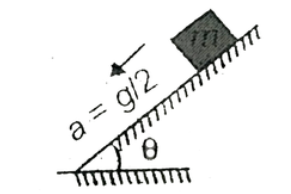500 J of work is done in sliding a 4 kg block up along a rough inclined plane to a vertical height of 10 m slowly. The work done against friction is (g=10ms2)
400J
100J
200J
Zero
To solve the problem, we need to determine the work done against friction when sliding a 4 kg block up a rough inclined plane to a vertical height of 10 m, given that the total work done is 500 J.
1. Identify the Given Values:
- Mass of the block, m=4kg
- Height, h=10m
- Total work done, Wtotal=500J
- Acceleration due to gravity, g=10m/s2
2. Calculate the Work Done Against Gravity:
The work done against gravity (potential energy gained) when lifting the block to a height h is given by the formula:
Wgravity=mgh
Substituting the values:
Wgravity=4kg×10m/s2×10m=400J
3. Set Up the Equation for Total Work Done:
The total work done is the sum of the work done against gravity and the work done against friction:
Wtotal=Wgravity+Wfriction
Rearranging this gives:
Wfriction=Wtotal−Wgravity
4. Substitute the Known Values:
Now, substitute the values we have calculated:
Wfriction=500J−400J=100J
5. Conclusion:
The work done against friction is 100J.
Final Answer:
The work done against friction is 100 J.
- Mass of the block, m=4kg
- Height, h=10m
- Total work done, Wtotal=500J
- Acceleration due to gravity, g=10m/s2
The work done against gravity (potential energy gained) when lifting the block to a height h is given by the formula:
Wgravity=mgh
Substituting the values:
Wgravity=4kg×10m/s2×10m=400J
The total work done is the sum of the work done against gravity and the work done against friction:
Wtotal=Wgravity+Wfriction
Rearranging this gives:
Wfriction=Wtotal−Wgravity
Now, substitute the values we have calculated:
Wfriction=500J−400J=100J
The work done against friction is 100J.
The work done against friction is 100 J.
Similar Questions
300J of work is done in slinding a 2 kg block up an inclined plane of height 10m. Taking g =10m/s2 , work done against friction is
View SolutionIf 250 J of work is done in sliding a 5 kg block up an inclined plane of height 4 m. Work done against friction is (g=10ms−2)
View SolutionIf 250 J of work is done in sliding a 5 kg block up an inclined plane of height 4 m. Work done against friction is (g=10ms−2)
View SolutionA block of mass m slides down a rough inclined plane with an acceleration g2

View SolutionA block of mass 2kg slipped up a slant plane requires 300J of work. If height of slant is 10m the work done against friction is :
View SolutionA crane pulls up a car of mass 500 kg to a vertical height of 4 m. Calculate the work done by the crane.
View SolutionA body is mass 300kg is moved through 10m along a smooth inclined plane of inclination angle 30∘. The work done in moving (in joules) is (g=9.8ms−2).
View SolutionA body of mass 10 kg is dropped to the ground from a height of 10 metres. The work done by the gravitational force is (g=9.8m/sec2)
View SolutionA block of mass 50 kg slides over a horizontal distance of 1m. If the coefficient of friction between their surface is 0.2, then work done against friction is (take g=9.8m/s2) :
View SolutionWhen a body of mass M slides down an inclined plane of inclination θ, having coefficient of friction μ through a distance s, the work done against friction is :
View Solution
